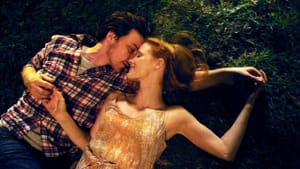Stay in the Loop
BSR publishes on a weekly schedule, with an email newsletter every Wednesday and Thursday morning. There’s no paywall, and subscribing is always free.
A film in three parts
Ned Benson's ‘Disappearance of Eleanor Rigby’

The Disappearance of Eleanor Rigby is not a trilogy, but something much more rare — a triptych. It is the same story told in three separate feature-length films. Each incarnation of the story takes a different approach, and there is no correct order in which to see them. This means that viewers have the refreshing choice and challenge of just how to watch this film.
Originally, writer-director Ned Benson created two feature films, subtitled Him and Her, which tell the story of a marriage falling apart in the wake of tragedy from the distinct perspectives of both spouses. Him follows Conor (James McAvoy) as he struggles to accept the end of his marriage to Eleanor (Jessica Chastain). The version called Her shows us just where Eleanor goes when she disappears and suffers through her own grief.
The third form of the story came later: When the Weinstein Company acquired The Disappearance of Eleanor Rigby, they asked for a version combining footage from Him and Her into a singular and more marketable film called Them. Nonetheless, the company did not abandon the originals. They are now distributing all three iterations of The Disappearance of Eleanor Rigby.
Inseparable stories
It is exciting to see a structurally experimental project being released in this way and not simply boiled down to the simplest marketing solution. The distribution model raises a new set of questions for viewers. For me, just purchasing the tickets required careful consideration: Should I watch the singular consolidated edit? Or sit through the two separate versions? And if so, in what order? I decided on a double feature: Him immediately followed by Her. For me, this back-to-back viewing proved to be essential because one version requires the other. Neither movie can stand on its own, but the act of stitching them together creates a rewarding viewing experience in and of itself.
First was the male perspective of Him. From the start, the audience is left in the dark about much of Conor’s story. This is deliberate — the film is only half the story after all — but the awareness of missing so much information is overwhelming. The result is a story that feels detached from context and a character that seems detached from the profound sadness of his wife. Her has the effect of filling in some of these gaps. It reveals what happens when Eleanor is offscreen in Him, and it fills out the emotional breadth of the family’s grief.
But of course, if Her seemed to be a more complete story, it is only because I watched it second. Had I seen this film in isolation, or had I reversed the order of my double feature, it too would have the same quality of emptiness that I observed in Him. The gaping holes in each film come with the territory of a project like this, but it means that on their own, both works are uninspired.
Unconcealed misremembering
The value of this project is in its structure. Telling and retelling the same story makes each iteration of the film an exercise in selective memory. We see how two individuals experience the same events but shape the story of their relationship into distinct and separate memories. While the content of the two stories overlaps, the actual footage does not. Any event or conversation that appears in both versions was filmed separately. Some visual cues distinguish the recurring scenes. For example, the color palette of Conor’s story is all cool blue tones, whereas Eleanor’s version is done in warm gold hues. The characters even wear different clothes from one version to the next — an unconcealed example of misremembering.
The more subtle differences manifest themselves in dialogue, glances, and tone of voice. The device at its most effective comes in the final scene of the films. Both Him and Her close with the opposite character whispering, “I love you.” And the beauty is that the correct version does not matter here. We cannot validate one memory as true and denounce the other — we can only explore the meaning in the inconsistency.
What the characters do in these films — the selective shaping of a story — is exactly what audience members have the chance to do here. We do our own editing of the truth by selecting a side of the story, determining the sequence of events. In this way, the experience of seeing The Disappearance of Eleanor Rigby is more rewarding than the content itself.
What, When, Where
The Disappearance of Eleanor Rigby. Written and directed by Ned Benson. Starring James McAvoy and Jessica Chastain.
Sign up for our newsletter
All of the week's new articles, all in one place. Sign up for the free weekly BSR newsletters, and don't miss a conversation.

 Kayleigh Butera
Kayleigh Butera